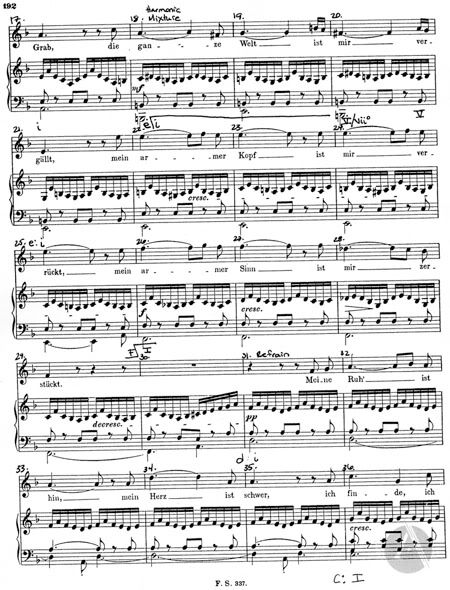I am going to analyze how Franz Schubert uses mixture, harmonic color, and rhythm to explore emotion and convey drama. I will also look at the form of the piece in connection with the text to see how the melody further expresses and strengthens the intensity of Gretchen's emotions and yearning.
Gretchen am Spinnrade is written in a loose ternary form, a three part structure. Schubert extends the first stanza by adding it after the third and sixth stanzas.
The lied begins with a rhythmic accompaniment, replicating the sound of a spinning wheel. This is not only suggested by an illustration but a literal continuous sixteenth note pattern in the right hand and the reciprocating motion of the treadle by the left hand that sets the scene. Gretchen begins to sing, expressing her most inner desires, leading the spinning wheel as her mind moves along with the rhythm of her hands.
1-11 mm.
The melody quickly changes from D minor to C major with elements of C minor. The pulsing harmonic rhythm building in intensity as the song moves to the second stanza.
English Translation [NAWM 305-306]:
My peace is gone,
my heart is heavy;
I'll never find peace,
never again.
13-21 mm.
Gretchen's distress worsens in the second and third stanzas as the harmony modulates from A minor, E minor and F major.
Where do I no have him
is to me like a tomb.
The whole world
is bitter to me.
22-29 mm.
My poor head is confused.
My poor mind
is torn apart.
31-40 mm.
Refrain:
We return to D minor cycling through to C Major and C Minor.
My peace is gone,
my heart is heavy;
I'll never find peace,
never again.
42-50 mm.
For him alone do I look
out the window.
For him alone do I go
out of the house.
51-58 mm.
His lofty bearing,
his noble figure,
the smile on his lips,
the strength of his gaze,
59-69 mm.
In my opinion this is the most dramatic moment in the piece, where the harmony moves from G minor, A flat-minor, and B flat-major. As she obsesses over kissing her lover between measures 66-68, she looses control and the accompaniment pattern stops-- declaring that she has also stopped the wheel:
and his conversation's
magical flow,
the press of his hand,
and, ah, his kiss!
71-82 mm.
My peace is gone,
my heart is heavy;
I'll never find peace,
never again.
84-92 mm.
The rising harmonic sequence in these final moments of the song further illustrates Gretchen's intense longing to embrace Faust in these next two stanzas.
My heart pines
for him.
Ash, if I could seize him
and hold him
92-100 mm.
and kiss him
all I wanted,
in his kisses
I would be lost!
101-102 mm.
Here, Schubert takes his own dramatic liberties and adds the line
"o konnt' ich ihn kussen" to fuel her longing.
Oh, if I could kiss him.
in his kisses
I would be lost!
114-118 mm.
My peace is gone,
my heart is heavy;
I'll never find peace,
never again.
-- Johann Wolfgang von Goethe







10 comments:
Thank you for this interesting analysis. I am just now learning this piece, and the breakdown of the sections has been very helpful to me. Cheers, Rachel
thank you very much
(:
Your analysis is well thought out and helped me with my own analysis, but you might want to rethink your analysis of the form. It seems that it is more of a Rhondo form (ABACADA) due to the returning of the first section after each introduction of new material. Just a suggestion.
Paul
One other thing, the songs begins in B minor, not D minor. If the song is in a minor key and has two sharps in the key signature with no consistently added accidentals in the music, then it cannot be in D minor. Instead it must be in the key that is the relative minor of D Major which is B minor. If you're not sure how to find a major key's relative minor, just go to a piano, start with the tonic of the major key, and move down three half steps.
Don't listen to Paul!
nice! thx for sharing! :)
@Paul - original piece is written in d-minor for soprano and was transposed in b-minor for mezzo-sopranos ... if it helps to understand why the analysis says it starts in d-minor ...
Thank you very much, Brenda
@Paul: Also, "Rondo" is really an instrumental form, not a song form. When analyzing song forms, you should treat the instrumental interludes as "breaks" in the form, not as independent sections (except in unusual circumstances). This song is ternary.
A comment from an accompanist: this is a difficult piece and it has to go fast, but not too fast at the beginning because you must keep something in reserve for the two climaxes - leading to "sein Kuss" and then to "an seinen Küssen vergehen".
This relates to the question of key, because the more black keys you have the greater the difficulty for the right hand. D minor (i.e where the first and last bass notes are D - not the singer's first note which is then F) is the best for this (and I think Schubert's original). But this takes the singer up to A' (on "vergehen"), and a mezzo will want something lower. As it happens, at the outdoor concert we are preparing I shall use a digital keyboard, so I shall cheat by using its transposing function (down four semi-tones), so she starts on a D, thinks the key is D minor and is happy...
Post a Comment